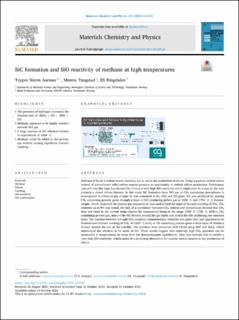| dc.contributor.author | Aarnæs, Trygve Storm | |
| dc.contributor.author | Tangstad, Merete | |
| dc.contributor.author | Ringdalen, Eli | |
| dc.date.accessioned | 2022-09-27T08:13:44Z | |
| dc.date.available | 2022-09-27T08:13:44Z | |
| dc.date.created | 2021-11-30T12:20:25Z | |
| dc.date.issued | 2021 | |
| dc.identifier.issn | 0254-0584 | |
| dc.identifier.uri | https://hdl.handle.net/11250/3021636 | |
| dc.description.abstract | Methane (CH4) is a carbon source currently not in use in the production of silicon. Using a gaseous carbon source instead of conventional solid carbon sources presents an opportunity to rethink silicon production. Preliminary research into this topic has shown CH4 to have a very high SiO reactivity and it might even be a step on the way towards a closed silicon furnace. In this study SiC formation from SiO gas in CH4 containing atmospheres is investigated. A reference gas of pure Ar was compared to H2, CH4 and CO gases. SiC was produced by passing CH4 containing process gases through a layer of SiO producing pellets gas at 1650 °C and 1750 °C. A thermocouple, which measured the process gas temperature, was used to look for signs of thermal cracking of CH4. CH4 contents up to 8% was tested, the lack of a correlation between CH4 content and temperature showed that CH4 does not crack in the current setup despite the temperature being in the range 1650 °C–1750 °C. With a CH4 containing process gas, most of the SiC formed around the gas inlets and within the SiO producing raw material layer. The reaction between SiO and CH4 occurred instantaneously when the two gases met, and appeared to be favored over thermal cracking of CH4. At 1650 °C in H2 or CO containing process gases a thick layer of whiskers formed around the rim of the crucible. The whiskers were examined with STEM using EDS and EELS, which determined the whiskers to be made of SiC. These results suggest that relatively high CH4 pressures can be metastable at temperatures far away from the thermodynamic equilibrium. They also indicate CH4 to exhibit a very high SiO reactivity, which makes it a promising alternative for current carbon sources in the production of silicon. | en_US |
| dc.language.iso | eng | en_US |
| dc.publisher | Elsevier | en_US |
| dc.rights | Navngivelse 4.0 Internasjonal | * |
| dc.rights.uri | http://creativecommons.org/licenses/by/4.0/deed.no | * |
| dc.subject | SiO condensation | en_US |
| dc.subject | SiO reactivity | en_US |
| dc.subject | Cracking | en_US |
| dc.subject | Silicon | en_US |
| dc.subject | Methane | en_US |
| dc.title | SiC formation and SiO reactivity of methane at high temperatures | en_US |
| dc.type | Peer reviewed | en_US |
| dc.type | Journal article | en_US |
| dc.description.version | publishedVersion | en_US |
| dc.rights.holder | © 2021 The Authors. Published by Elsevier B.V | en_US |
| dc.source.pagenumber | 1-7 | en_US |
| dc.source.volume | 276 | en_US |
| dc.source.journal | Materials Chemistry and Physics | en_US |
| dc.identifier.doi | 10.1016/j.matchemphys.2021.125355 | |
| dc.identifier.cristin | 1961622 | |
| dc.source.articlenumber | 125355 | en_US |
| cristin.ispublished | true | |
| cristin.fulltext | original | |
| cristin.qualitycode | 1 | |

